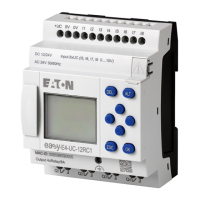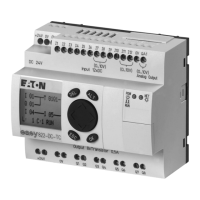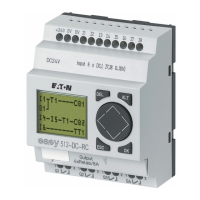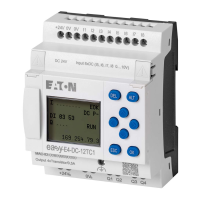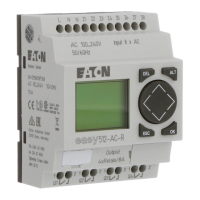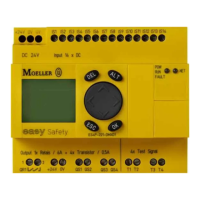5. Programming on the device
5.7 Using operands in a program
5.7.6 Organizing marker ranges
The term "marker" is used to represent marker bits (M). Marker bits (M) are used to
store the Boolean states 0 or 1. A marker bit is also called an auxiliary relay.
easyE4 devices also manage the marker bits in marker bytes (MB), marker words
(MW) and in marker double words (MD). A marker byte consists of 8 marker bits, a
marker word of 16 marker bits and a marker double word of 32 marker bits.
In order to store the state for a contact, you can use a specific bit and, accordingly a
specific byte as well. For instance, marker bit 9 is included in marker byte 2, marker
word 1, and marker double word 1. You can use the following conversion table to
determine which word contains a bit or which bits encompass a specific double
word.
Bear in mind that after the division, a rounding up to the next higher integer is neces-
sary, even if the decimal number is below 0.5.
The easyE4 has 1024 bytes available for data storage.
This data memory can be accessed by bit, byte, word, or double word.
This means that four different operands with their own address can be used to
access the exact same data range. Accordingly, it is extremely important to pay
close attention to each operand's address in order to avoid accidental duplicate
access.
Markers can be used to access data as follows (with the corresponding address
range):
l
M 1...512
l
MB 1...512
l
MW 1...512
l
MD1...256
Avoid accidental double marker assignments.
Otherwise you might address the 512 bit markers sim-
ultaneously via the first 64 marker bytes, 32 marker words or
16 marker double words and thus produce uncontrollable
states. When write accesses are made successively within
an MD, such as to MD1, MW2, MB4 or M32, the last write
operation is retained.
Observing the following wiring rules will prevent the double assignment of
marker bits.
For easyE4, use:
Marker bytes, starting at MB13
Marker words, starting at MW07
Marker double words, starting at MD04
234
easyE402/24 MN050009ENEaton.com
